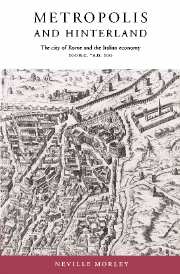Book contents
- Frontmatter
- Contents
- List of maps and figures
- Preface
- List of abbreviations
- Introduction: Rome and Italy
- 1 The metropolitan city in a pre-industrial economy
- 2 The demographic burden
- 3 A model of agricultural change
- 4 The transformation of the Roman suburbium
- 5 Agricultural development in central Italy
- 6 Exploiting the margins
- 7 Marketing and urbanisation
- Conclusion
- Bibliography
- Index
2 - The demographic burden
Published online by Cambridge University Press: 17 August 2009
- Frontmatter
- Contents
- List of maps and figures
- Preface
- List of abbreviations
- Introduction: Rome and Italy
- 1 The metropolitan city in a pre-industrial economy
- 2 The demographic burden
- 3 A model of agricultural change
- 4 The transformation of the Roman suburbium
- 5 Agricultural development in central Italy
- 6 Exploiting the margins
- 7 Marketing and urbanisation
- Conclusion
- Bibliography
- Index
Summary
The urban population
The city of Rome was, by pre-modern standards, an exceptionally large city. The views of contemporaries, the sheer scale of its buildings and a large quantity of incidental anecdotal evidence make this plain; as Hermansen notes: ‘A city which absorbs 3,000 foreign chorus girls has a considerable population.’ However, it is difficult to move beyond such vague impressions to make more detailed statements about the city's size or the dynamics of its growth. Upon close examination, the concept of ‘the population of Rome’ becomes increasingly elusive. The city's inhabitants were always changing; at any one time they could include tourists, merchants on a regular visit, farmers in for market, immigrants who were likely to die there and natives who still hoped to get out. ‘Rome’ itself was ill-defined enough. According to the Digest, ‘Urbis relates to the area within the walls; Romae, however, also includes the adjoining buildings, which is a larger area’; and Dionysius of Halicarnassus observed how difficult it was to decide where the buildings ended and the countryside began.
For many purposes it is unnecessary to offer a more precise definition or quantification of the urban population; it is enough that Rome was the greatest city of the ancient Mediterranean. This is insufficient for the present argument. The impact of large cities on their hinterlands depends to a very great extent on the growth of their populations and hence their demands for resources.
- Type
- Chapter
- Information
- Metropolis and HinterlandThe City of Rome and the Italian Economy, 200 BC–AD 200, pp. 33 - 54Publisher: Cambridge University PressPrint publication year: 1996
- 3
- Cited by

